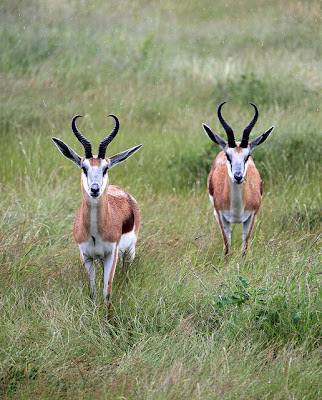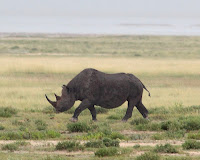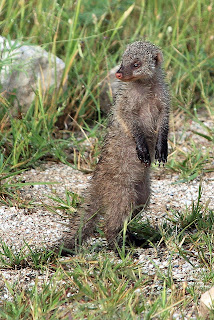Temporarily chastened by my “no room at the inn” arrival in Cape Town, I took the unusual step of making a hotel reservation before landing in Windhoek. When I arrived at the airport a driver was even holding up a sign with my name on it. Windhoek’s airport is about 40 kilometers from the city. “Why did they build it so far away?” I asked Paul, the driver.
“No flat ground any closer,” Paul told me, pointing to the dune-shaped, brush-covered hills on both sides of the road. I had what I imagine is a typically Western thought: Isn’t that what bulldozers are for?
I spent two days wandering around Windhoek. Anyone who didn’t already know that Namibia was once a German colony could have guessed from the street names, an eclectic mix of German (Banhofstrasse, Bismark Street, Beethovenstrasse), African (Robert Mugabe Avenue, Sam Nujoma Drive, Mandume Ndemufayo Street) and Other (Fidel Castro Street, Florence Nightingale Street). While exploring the city I stopped by a safari operator and booked a camping trip to the country’s two most popular tourist destinations: Etosha National Park and Sossusvlei.
“Working at a lion rehabilitation farm.”
“You got to hang out with lions for free?”
“No,” she said. “It cost 1,500 Euros.” Hmm… In that case I guess I’d also volunteered in South Africa when I paid $500 to spend four days working as a wildlife spotter in Kruger National Park. It really felt great to give back to the community.
Early Saturday morning I left on a three-day tour of Etosha. Covering 22,000 square kilometers (roughly the size of Vermont) on the northwestern edge of the Kalahari, Etosha is one of southern Africa’s top game parks. Most of the African wildlife stars – lions, leopards, cheetahs, elephants, giraffes, zebras, rhinos – can be found there, but I’d been warned this was not the best time to visit. In the dry season the Etosha animals congregate around a limited number of watering holes, which makes them relatively easy to spot. But the rainy season was still in full swing and the abundant supply of water allowed the animals to spread out.
There were only four other tourists in my group – Julia, Jean, Edwin, and Giacomo – all solo travelers from Europe, all interesting characters. It took us most of the day to drive from Windhoek to Etosha, and along the way we started to get to know each other.
Julia, a 40-something, redheaded architectural engineer from England, had, like me, left her job to travel and was, also like me, a little over halfway into a year-long trip around the world. More cerebral than most of the other travelers I’d met, Julia said she’d already read 100 books on her trip. And she rarely missed an opportunity to share her knowledge (“Hippopotamus is a Greek work that means ‘water cow,’” she volunteered at one point).
Jean, now retired and living in Cape Town, used to own and run a delivery business in Belgium. He said he was passionate about cycling and had biked across six continents, including a tour of the U.S. that took him all the way from Miami to San Francisco. “In San Francisco I stay at a hotel where Herbert Hoover also stay,” he said with a laugh.
Edwin, a German in his 50s, was a professional gardener who always smiled when he spoke. He told me he usually runs 10 marathons a year, a fact I couldn’t quite reconcile with his prominent pot-belly. Initially I thought Edwin was quiet and reserved, but I soon realized that was due more to his poor command of English than his personality. He and Jean became fast friends and spent the entire ride to Etosha talking in rapid-fire German and giggling like schoolkids.
Speaking of schoolkids, Giacomo was by far the youngest in our group – just 16 years old. He was spending a semester in Windhoek on a student exchange program, and he’d decided to take advantage of a school holiday to see more of the country. Giacomo (“You say it JAH-kuh-mo,” he told me) had been born in Italy but his family now lived in Germany. He was tall (“I am 1.93 meters”), with a droopy chin and light hair.
We reached Etosha in the late afternoon and looked for wildlife as we drove to our inside-the-park campsite. Our first animal sighting was a gemsbok (also called an oryx), a tough desert antelope with horns that can grow up to three feet long. “Wunderbar!” yelled Edwin. “Oh my God!”
Julia corrected me in the same patient, patronizing tone of voice that British mothers must use when their children say something outlandish. “I’m afraid it’s a bit cloudy for that, now isn’t it?” she said, not a question but a statement. The sun did end up peeking through a small hole in the clouds just before it set. We watched the colorful light reflect off the surface of a watering hole near our campsite.
Here’s a kid hardly older than my nieces, I thought, who’s completely comfortable hanging out in Namibia with a group of strangers more than twice his age. Giacomo already spoke four languages and understood several more. He was a hundred times more cosmopolitan and confident than I was at 16, and yet he still acted like a kid – in the best sense – earnest, idealistic, and curious about everything.
We spent the entire next day looking for animals. We didn’t find cheetahs, leopards, or elephants, and the only lions we saw were just two black dots in the distance. I was glad Marcus kept our expectations low. We knew we wouldn’t see much, so we were happy to watch the more common animals – springboks, wildebeests, black-faced impalas, hartebeests, and all the different birds.
I decided to see how she’d respond to a little bit of her own medicine. “Behavioral Economics has a word to describe that dynamic,” I said. “It’s called ‘anchoring.’” Julia scrutinized me for a moment, frowned, and then changed the subject.




































This comment has been removed by the author.
LikeLike
Hi Robert,
May I use one of your pictures on my website?
Watering Hole Sunset Panorama
Please let me now,
Thank you
James
jlynch@gmail.com
LikeLike
Curious, how did you score the gig as a wildlife spotter in Kruger? Thanks.
LikeLike